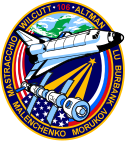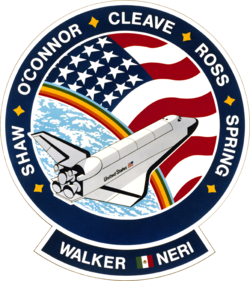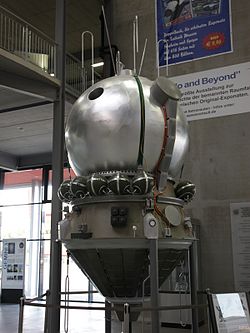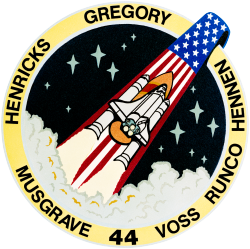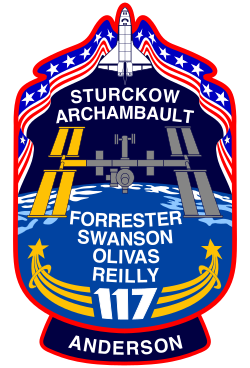Atlantis (rymdfärja)
- För andra betydelser, se Atlantis (olika betydelser).
| Atlantis OV‑104 | |
 Atlantis skjuts upp på dess STS-122-uppdrag för att docka med Internationella rymdstationen | |
| OV-beteckning | OV-104 |
|---|---|
| Land | USA |
| Kontraktstilldelning | 29 januari 1979 |
| Namngiven efter | RV Atlantis |
| Status | Pensionerad. Utställd på Kennedy Space Center Visitor Complex i Florida. |
| Första flygning | STS-51-J 3–7 oktober 1985 |
| Sista flygning | STS-135 8–21 juli 2011 |
| Antal uppdrag | 33 |
| Besättningsmedlemmar | 207[1] |
| Tid i rymden | 306 dagar, 14 timmar, 12 minuter, 43 sekunder fr.o.m STS-135 |
| Antal genomförda omloppsvarv | 4 848 |
| Tillryggalagd sträcka | 202 673 974 km fr.o.m STS-135 |
| Satelliter utplacerade | 14 |
| Mir-dockningar | 7 |
| ISS-dockningar | 12 |
Atlantis (OV-104) är en av de rymdfärjor som tillhörde den amerikanska rymdflygstyrelsen Nasa. Atlantis var den fjärde rymdfärjan som byggdes. Atlantis gjorde sin första flygning i oktober 1985, då den användes för ett militärt uppdrag, liksom de nästkommande fyra flygningarna. Efter detta har färjan använts för andra, mer civila uppdrag. Med start 1995 gjorde Atlantis sju resor på raken till den ryska rymdstationen Mir.
Från november 1997 till juli 1999 byggdes färjan om för att kunna utföra konstruktionsarbeten på den internationella rymdstationen ISS, runt 165 ändringar gjordes. Efter systerfärjan Columbias haveri i början av 2003 gjordes ytterligare ändringar med Atlantis och de då kvarvarande systerfärjorna Endeavour och Discovery. Dessa ändringar har främst syftat till att förbättra färjornas driftsäkerhet. Atlantis trettioandra planerade flygning var uppdraget STS-132 till ISS med start den 14 maj 2010 och landning den 26 maj 2010.
Atlantis genomförde det sista planerade uppdraget, STS-135, med start 8 juli 2011.
Numera finns Atlantis i en utställning på Kennedy Space Center.
Konstruktion

Vid konstruktionen av Atlantis utnyttjades de erfarenheter man lärt från dess föregångare. Färjans tjänstevikt kunde reduceras med 3 ton jämfört med Columbia, Nasas första rymdfärja. Dessutom behövdes bara halva tiden för att färdigställa Atlantis.
Rymdfärdsuppdragen
| Nasarymdfärjan Atlantis | ||||||
|---|---|---|---|---|---|---|
 | ||||||
| Uppdragsemblem för Atlantis flygningar | ||||||
 |  | 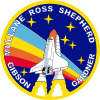 |  |  | 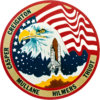 |  |
 |  | 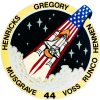 |  |  |  |  |
 |  | 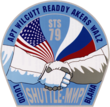 |  |  |  |  |
 |  |  |  |  |  |  |
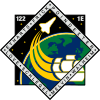 |  |  |  |  | ||
Populärkultur
År 1998 medverkade Atlantis i filmen Armageddon, där hon förstördes av splitter från en gigantisk asteroid.
Referenser
- ^ Gebhardt, Chris (31 december 2011). ”Year in Review – Part 4: Saying Goodbye to Discovery, Atlantis, and Endeavour” (på engelska). Spaceflight.com. http://www.nasaspaceflight.com/2011/12/year-in-review-p4-saying-goodbye-discovery-atlantis-endeavour/. Läst 1 januari 2012.
Externa länkar
 Wikimedia Commons har media som rör Atlantis (rymdfärja).
Wikimedia Commons har media som rör Atlantis (rymdfärja).- NASA - Atlantis (OV-104)
- Den här artikeln är helt eller delvis baserad på material från engelskspråkiga Wikipedia, tidigare version.
| ||||||||
| |||||||||||
| |||||||||||||||||||||||||||||||||
Media som används på denna webbplats
STS-79 was the fourth in a series of NASA docking missions to the Russian Mir Space Station, leading up to the construction and operation of the International Space Station (ISS). As the first flight of the Spacehab Double Module, STS-79 encompassed research, test and evaluation of ISS, as well as logistics resupply for the Mir Space Station. STS-79 was also the first NASA-Mir American crew member exchange mission, with John E. Blaha (NASA-Mir-3) replacing Shannon W. Lucid (NASA-Mir-2) aboard the Mir Space Station. The lettering of their names either up or down denotes transport up to the Mir Space Station or return to Earth on STS-79. The patch is in the shape of the Space Shuttle's airlock hatch, symbolizing the gateway to international cooperation in space. The patch illustrates the historic cooperation between the United States and Russia in space. With the flags of Russia and the United States as a backdrop, the handshake of Extravehicular Mobility Unit (EMU) which are suited crew members symbolizes mission teamwork, not only of the crew members but also the teamwork between both countries space personnel in science, engineering, medicine and logistics.
STS-27 Mission Insignia
STS-34 Mission Insignia
Emblem of Nasa's STS-110 mission.
- The STS-110 mission begins the third and final phase of construction for the International Space Station (ISS) by delivering and installing the SØ truss segment that will be carried into orbit in the payload bay of the Space Shuttle Atlantis. The Station’s robotic arm will remove the SØ segment from the Shuttle’s payload bay and place it on top of the United States Laboratory. During several space walks, SØ will be mechanically attached to ISS, and then multiple cables will be connected allowing electrical power and communications to flow between SØ and ISS. The STS-110 crew patch is patterned after the cross section of the SØ truss, and encases the launch of the Shuttle Atlantis and a silhouette of the ISS as it will look following mission completion. The successfully installed SØ segment is highlighted in gold. The SØ truss will serve as the cornerstone for the remaining ISS truss segments which together will span a distance greater than the length of a football field. This truss holds the Station’s massive solar arrays, providing electrical power for the modules of all the International Partners, and enables ISS to reach its full potential as a world-class research facility.
Space Shuttle Atlantis begins the STS-132 mission as it carries the six-member crew toward the International Space Station.
The STS-135 patch represents the space shuttle Atlantis embarking on its mission to resupply the International Space Station. Atlantis is centered over elements of the NASA emblem depicting how the space shuttle has been at the heart of NASA for the last 30 years. It also pays tribute to the entire NASA and contractor team that made possible all the incredible accomplishments of the space shuttle. Omega, the last letter in the Greek alphabet, recognizes this mission as the last flight of the Space Shuttle Program.
STS-104, International Space Station (ISS) assembly mission 7A, marks the completion of the initial assembly phase of ISS. The 7A crew will install, activate, and perform the first space walk from the Joint Airlock. The Joint Airlock will enable crews to perform space walks in either United States or Russian spacesuits while recovering over 90 percent of the gases that were previously lost when airlocks were vented to the vacuum of space. This patch depicts the launch of Space Shuttle Atlantis and the successful completion of the mission objectives as signified by the view of the ISS with the airlock installed. The astronaut symbol is displayed behind Atlantis as a tribute to the many crews that have flown before. The hard work, dedication, and teamwork of the airlock team is represented by the ISS components inside the payload bay which include the Joint Airlock and four high pressure gas tanks containing nitrogen and oxygen. In the words of a STS-104 crew spokesperson, "The stars and stripes background is symbolic of the commitment of a nation to this challenging international endeavor and to our children who represent its future."
Emblem of Nasa's STS-125 mission.
STS-45 Mission Insignia
The crew patch for STS-81 , the fifth Shuttle-Mir docking mission, is shaped to represent the Roman numeral V. The Shuttle Atlantis is launching toward a rendezvous with Russia's Mir Space Station, silhouetted in the background. Atlantis and the STS-81 crew spent several days docked to Mir during which time Jerry M. Lineger (NASA-Mir-4) replaced astronaut John Blaha (NASA-Mir-3) as the U.S. crew member onboard Mir. The U.S. and Russian flags are depicted along with the names of the shuttle crew.
CAPE CANAVERAL, Fla. – At NASA's Kennedy Space Center in Florida, flags flap in the breeze off the Atlantic Ocean at Launch Pad 39A. Space shuttle Atlantis has reached the end of its 3.4-mile journey, known as rollout, from the Vehicle Assembly Building. First motion was at 6:38 a.m. EDT Oct. 14. The rollout took about six hours, and the shuttle was secure or "hard down" on the pad at 1:31 p.m. Liftoff of Atlantis on its STS-129 mission to the International Space Station is targeted for Nov. 12. For information on the STS-129 mission and crew, visit http://www.nasa.gov/mission_pages/shuttle/shuttlemissions/sts129/index.html.
STS-66 Mission Insignia
Imitation of the STS-101 mission patch, which commemorates the third Space Shuttle flight supporting the assembly of the International Space Station (ISS). This flight's primary tasks are to outfit the ISS and extend its lifetime, and to conduct a spacewalk to install external components in preparation for the docking of the Russian Service Module, Zvezda, and the arrival of the first ISS crew. The Space Shuttle is depicted in an orbit configuration prior to docking with the ISS. The ISS is depicted in the stage of assembly completed for the STS-101 mission, which consists of the United States-built Unity module and the Russian-built Zarya module. The three large stars represent the third ISS mission in the assembly sequence. The elements and colors of the border reflect the flags of the nations represented by the STS-101 crew members, the United States and Russia. The NASA insignia design for Shuttle flights is reserved for use by the astronauts and for other official use as the NASA Administrator may authorize. Public availability has been approved only in the form of illustrations by the various news media. When and if there is any change in this policy, which is not anticipated, it will be publicly announced.
BEWARE: This drawing is similar to the original patch (File:Sts-101-patch.png), but not identical.STS-46 Mission Insignia
The STS-86 flight was the seventh shuttle-Mir docking mission, symbolized by seven stars. The international crew includes astronauts from the United States, Russia, and France. The flags of these nations are incorporated in the rays of the astronaut logo. The rays of light streaking across the sky depict the orbital tracks of the two spacecraft as they prepare to dock. During the flight, an American astronaut and a Russian cosmonaut will perform an extravehicular activity (EVA). The mercator projection of Earth illustrates the global cooperative nature of the flight.
This is the crew patch for the STS-106 mission, which is the first Shuttle flight to the International Space Station since the arrival of its newest component, the Russian-supplied Service Module Zvezda (Russian for star). Zvezda is depicted on the crew patch mated with the already orbiting Node 1 Unity module and Russian-built Functional Cargo Block, called Zarya (sunrise), with a Progress supply vehicle docked to the rear of the Station. The International Space Station is shown in orbit with Earth above as it appears from the perspective of space. The Astronaut Office symbol, a star with three rays of light, provides a connection between the Space Shuttle Atlantis and the Space Station, much the same as the Space Shuttle Program is linked to the International Space Station during its construction and future research operations. Stylized versions of flags from Russia and the United States meet at the Space Station. They symbolize both the cooperation and joint efforts of the two countries during the development and deployment of the permanent outpost in space as well as the close relationship of the American and Russian crew members.
STS-61-B mission patch
This is the insignia designed by the STS-61B crewmembers to represent their November 1985 mission aboard the Space Shuttle Atlantis, depicted here in earth orbit, making only its second space flight. The design is surrounded by the surnames of the seven crewmembers.
Flames from the main engines on Space Shuttle Atlantis, at ignition, pour through the mobile launcher platform into the flame trench below. Within seconds, Atlantis was on its climb into space and a rendezvous with the International Space Station on mission STS-122. Liftoff was on time at 2:45 p.m. (EST). This is the third launch attempt for Atlantis since December 2007 to carry the European Space Agency's Columbus laboratory to the station. During the mission, the crew's prime objective is to attach the laboratory to the Harmony module, adding to the station's size and capabilities. Onboard are astronauts Steve Frick, commander; Alan Poindexter, pilot; Leland Melvin, Rex Walheim, ESA's Hans Schlegel, Stanley Love and ESA's Leopold Eyharts, all mission specialists. Eyharts will join Expedition 16 in progress to serve as a flight engineer aboard the ISS.
STS-51-J Mission Insignia
Emblem of Nasa's STS-122 mission.
- The STS-122 patch depicts the continuation of the voyages of the early explorers to today's frontier, space. The ship denotes the travels of the early expeditions from the east to the west. The space shuttle shows the continuation of that journey along the orbital path from west to east. A little more than 500 years after Columbus sailed to the new world, the STS-122 crew will bring the European laboratory module "Columbus" to the International Space Station to usher in a new era of scientific discovery.
Författare/Upphovsman: Pascal (Flickr user: pasukaru76), Licens: CC0
Vostok spacecraft replica at the Technik Museum Speyer, Germany.
STS-74 Mission Insignia
- The STS-74 crew patch depicts the orbiter Atlantis docked to the Russian Space Station Mir. The central focus is on the Russian-built docking module, drawn with shading to accentuate its pivotal importance to both STS-74 and the NASA-Mir Program. The rainbow across the horizon represents the Earth's atmosphere, the thin membrane protecting all nations, while the three flags across the bottom show those nations participating in STS-74: Russia, Canada, and the United States. The sunrise is symbolic of the dawn of a new era in NASA space flight , that of International Space Station construction.
STS-37 Mission Insignia
STS-43 Mission Insignia
- Designed by the astronauts assigned to fly on the mission, the STS 43 patch portrays the evolution and continuity of the USA's space program by highlighting 30 years of American manned space flight experience -- from Mercury to the Space Shuttle. The emergence of the Shuttle Atlantis from the outlined configuration of the Mercury space capsule commemorates this special relationship. The energy and momentum of launch are conveyed by the gradations of blue which mark the Shuttle's ascent from Earth to space. Once in Earth orbit, Atlantis' cargo bay opens to reveal the Tracking and Data Relay Satellite (TDRS) which appears in gold emphasis against the white wings of Atlantis and the stark blackness of space. A primary mission objective, the Tracking and Data Relay Satellite System (TDRSS) will enable almost continuous communication from Earth to space for future Space Shuttle missions. The stars on the patch are arranged to suggest this mission's numerical designation, with four stars left of Atlantis and three to the right.
STS-44 Mission Insignia
STS-36 Mission Insignia
This is a printable version of space shuttle Atlantis' orbiter tribute, or OV-104, which hangs in Firing Room 4 of the Launch Control Center at NASA's Kennedy Space Center in Florida. In the lower-left corner, it features Atlantis soaring above Earth and threaded through the design are the mission patches for each of Atlantis' flights. Atlantis' accomplishments include seven missions to the Russian space station Mir and several assembly, construction and resupply missions to the International Space Station. Atlantis also flew the last Hubble Space Telescope servicing mission on STS-125. In the tribute, the planet Venus represents the Magellan probe being deployed during STS-30, and Jupiter represents the Galileo probe being deployed during STS-34. The inset photos illustrate various aspects of shuttle processing as well as significant achievements, such as the glass cockpit and the first shuttle docking with Mir during STS-71. The inset photo in the upper-left corner shows a rainbow over Atlantis on Launch Pad 39A and shuttle Endeavour on Launch Pad 39B at Kennedy. Endeavour was the assigned vehicle had Atlantis' STS-125 mission needed rescue, and this was the last time both launch pads were occupied at the same time. The stars in the background represent the many people who have worked with Atlantis and their contributions to the vehicle's success. Five orbiter tributes are on display in the firing room, representing Atlantis, Challenger, Columbia, Endeavour and Discovery.
STS-38 Mission Insignia
This is an imitation of the mission patch of space shuttle mission STS-115 (ISS assembly mission 12A). It was designed by Graham Huber, Peter Hui and Gigi Lui at York University in Toronto, Canada. The patch depicts Space Shuttle ''Atlantis'' approaching the International Space Station. As it heads for the space station, (which is actually depicted in the center right of the patch, in its configuration after STS-115) it leaves the Astronaut Symbol. Behind the shuttle are solar arrays, hence it is the first shuttle mission to deliver solar arrays since the Columbia disaster. It is also the first truss assembly mission since STS-113. The names of the crew are depicted along the border. When there is any change in this policy, please let Wikipedia or NASA know. The patch is visible in the background of a scene in the movie Transformers 3: Dark of the Moon at around the time of 1 hour, 25 minutes. BEWARE: This drawing is similar to the original patch (File:STS-115 patch.png), but not identical.
The STS-117 crew patch symbolizes the continued construction of the International Space Station (ISS) and our ongoing human presence in space. The ISS is shown orbiting high above the Earth. Gold is used to highlight the portion of the ISS that will be installed by the STS-117 crew. It consists of the second starboard truss section, S3/S4, and a set of solar arrays. The names of the STS-117 crew are located above and below the orbiting outpost. The two gold astronaut office symbols, emanating from the '117' at the bottom of the patch represent the concerted efforts of the shuttle and station programs toward the completion of the station. The orbiter and unfurled banner of red, white and blue represent our Nation's renewed patriotism as we continue to explore the universe.
The STS-112 emblem symbolizes the ninth assembly mission (9A) to the International Space Station (ISS), a flight which is designed to deliver the Starboard 1 (S1) truss segment. The 30,000 pound truss segment will be lifted to orbit in the payload bay of the Space Shuttle Atlantis and installed using the ISS robotic arm. Three space walks will then be carried out to complete connections between the truss and ISS. Future missions will extend the truss structure to a span of over 350 feet so that it can support the solar arrays and radiators which provide the electrical power and cooling for ISS. The STS-112 emblem depicts ISS from the viewpoint of a departing shuttle, with the installed S1 truss segment outlined in red. A gold trail represents a portion of the Shuttle rendezvous trajectory. Where the trajectory meets ISS, a nine-pointed star represents the combined on-orbit team of six shuttle and three ISS crew members who together will complete the S1 truss installation. The trajectory continues beyond the ISS, ending in a six-pointed star representing the Atlantis and the STS-112 crew.
STS-71 Mission Insignia
The STS-71 crew patch design depicts the orbiter Atlantis in the process of the first international docking mission of the Space Shuttle Atlantis with the Russian Space Station Mir. The names of the 10 astronauts and cosmonauts who flew aboard the orbiter are shown along the outer border of the patch. The rising sun symbolizes the dawn of a new era of cooperation between the two countries. The vehicles Atlantis and Mir are shown in separate circles converging at the center of the emblem symbolizing the merger of the space programs of the two space faring nations. The flags of the United States and Russia emphasize the equal partnership of the mission. The joint program symbol at the lower center of the patch acknowledges the extensive contributions made by the Mission Control Centers (MCC) of both countries. The crew insignia was designed by aviation and space artist, Bob McCall, who also designed the crew patch for the Apollo Soyuz Test Project (ASTP) in 1975, the first international space docking mission.
The STS-132 mission will be the 32nd flight of the space shuttle Atlantis. The primary STS-132 mission objective is to deliver the Russian-made MRM-1 (Mini Research Module) to the International Space Station (ISS). Atlantis will also deliver a new communications antenna and a new set of batteries for one of the ISS solar arrays. The STS-132 mission patch features Atlantis flying off into the sunset as the end of the Space Shuttle Program approaches. However the sun is also heralding the promise of a new day as it rises for the first time on a new ISS module, the MRM-1, which is also named Rassvet, the Russian word for dawn.
STS-76 Mission Insignia
The STS-30 patch depicts the joining of NASA's manned and unmanned space programs. The sun and inner planets of our solar system are shown with the curve connecting Earth and Venus symbolizing the shuttle orbit, the spacecraft trajectory toward Venus, and its subsequent orbit around our sister planet. A Spanish caravel similar to the ship on the official Magellan program logo commemorates the 16th century explorer's journey and his legacy of adventure and discovery. Seven stars on the patch honor the crew of Challenger. The five-star cluster in the shape of the constellation Cassiopeia represent the five STS-30 crewmembers - Astronauts David Walker, Ronald Grabe, Norman Thagard, Mary Cleave and Mark Lee - who collectively designed the patch.
For STS-129 the sun shines brightly on the International Space Station (ISS) above and the United States below representing the bright future of U.S. human spaceflight. The contiguous U.S., Rocky Mountains, and Great Desert Southwest are clearly visible on the earth below encompassing all the NASA centers and the homes of the many dedicated people that work to make our Space Program possible. The integrated shapes of the patch signifying the two Express Logistics Carriers that will be delivered by STS-129 providing valuable equipment ensuring the longevity of the ISS. The Space Shuttle is vividly silhouetted by the sun highlighting how brightly the Orbiters have performed as a workhorse for the U.S. Space Program over the past 3 decades. The Space Shuttle ascends on the Astronaut symbol portrayed by the Red, White and Blue swoosh bounded by the gold halo. This symbol is worn with pride by this U.S. crew representing their country on STS-129. The names of the crew members are denoted on the outer band of the patch. As STS-129 launches, the Space Shuttle is in its twilight years. This fact is juxtaposed by the 13 stars on the patch which are symbolic of our children who are the future. The Moon and Mars feature predominantly to represent just how close humankind is to reaching further exploration of those heavenly bodies and how the current Space Shuttle and ISS missions are laying the essential ground work for those future endeavors.
The STS-84 emblem depicts the Space Shuttle Atlantis launching into Earth orbit to join the Russian Space Station Mir as part of Phase One (Shuttle-Mir) of the International Space Station program. The names of the eight astronauts who flew onboard Atlantis, including the two who changed their positions onboard Mir for a long duration flight, are shown along the border of the patch. The STS-84/Mir-23 team will transfer 7,000 pounds of experiments, Station hardware, food and clothing to and from Mir during the five-day period of docking. The Phase One program is represented by the rising Sun and by the Greek letter Phi followed by one star. This sixth Shuttle-Mir docking mission is symbolized by the six stars surrounding the word Mir in Cyrillic characters. Combined, the seven stars symbolize the current configuration of Mir, composed of six modules launched by the Russians and one module brought up by Atlantis on a previous docking flight.
This is the insignia for STS-98, which marks a major milestone in assembly of the International Space Station (ISS).
- Atlantis' crew will deliver the United States Laboratory, Destiny, to the ISS. Destiny will be the centerpiece of the ISS, a weightless laboratory where expedition crews will perform unprecedented research in the life sciences, materials sciences, Earth sciences, and microgravity sciences. The laboratory is also the nerve center of the Station, performing guidance, control, power distribution, and life support functions. With Destiny's arrival, the Station will begin to fulfill its promise of returning the benefits of space research to Earth's citizens.
- The crew patch depicts the Space Shuttle with Destiny held high above the payload bay just before its attachment to the ISS. Red and white stripes, with a deep blue field of white stars, border the Shuttle and Destiny to symbolize the continuing contribution of the United States to the ISS. The constellation Hercules, seen just below Destiny, captures the Shuttle and Station's team efforts in bringing the promise of orbital scientific research to life. The reflection of Earth in Destiny's window emphasizes the connection between space exploration and life on Earth.

















